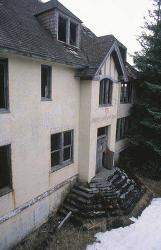
SEWARD: Statewide school could rise from ruin of historic orphanage.
By ALEX deMARBAN
Anchorage Daily News
Published: May 1, 2006
Last Modified: May 1, 2006 at 09:48 AM
Jim Simpson was 4 years old when his father, a Chickaloon miner who wanted a better life for his son, put him on the train in Anchorage and sent him to live in the Jesse Lee Home.
It was 1929 and the three-story orphanage on a Seward hillside had been open for four years.
In a way Simpson helped build the orphanage. At the age of 7, he cleared rocks to make farmland in the shadow of the Tudor-style mansion. As a teenager, he ran the bakery and planted carrots, potatoes and other vegetables to feed more than 100 fellow Native children. Many of them came from villages ravaged by influenza and TB epidemics.
Now the 81-year-old former educator is leading an effort to rebuild the home. Saddened by its crumbling condition during a visit two years ago -- it was abandoned to the rain and snow in 1965 -- he's rallied a group of prominent Alaska leaders to save it.
They hope to build a statewide school -- possibly a boarding school -- from the orphanage's remains. The home where John "Benny" Benson Jr. designed the state flag and thousands of children outgrew hopeless beginnings shouldn't be left to rot in the elements, he said.
"It's an eyesore and it should be something people are proud of," said Simpson, an Athabascan.
In Anchorage meetings over the past year the group created a nonprofit organization, Friends of the Jesse Lee Home, to accept tax-deductible donations. They've won over the Rasmuson Foundation, which has offered to pay for half of a $200,000 feasibility study.
The study will consider Alaska's educational needs and the type of school that should be built, said Cook Inlet Regional Inc. chief executive and Friends member Margie Brown.
Restoration for history's sake isn't enough, she said. The mansion needs a long-term purpose to justify costly repairs that architects say could exceed $12 million.
One idea is a boarding school similar to Mt. Edgecumbe in Southeast Alaska that offers an alternative to tiny Bush schools with high drop-out rates and steady teacher turnover, she said.
Whatever type of school is built, she said, Seward is an ideal location. It's closer to most villages than Mt. Edgecumbe and offers small-town advantages with highway access to big cities like Anchorage.
Former state senator and Friends member Arliss Sturgulewski likes another idea: a statewide leadership school that gives rural students with behavioral problems new opportunities.
The school's prominent graduates, including Alaska Pacific University founder Peter Gordon Gould, could give hope to troubled Native youths, she said.
"It's a wonderful history and I just think it's really sad that nothing has been done to this point," Sturgulewski said. "This is something worth saving for all of Alaska."
The orphanage, first established by the Methodist Church in Unalaska, moved to Seward in 1925. Materials and food were cheaper at the head of Resurrection Bay than in the Aleutian Islands. But the massive 1964 Good Friday earthquake destroyed one of the institution's buildings and severely damaged two others, the boy's dormitory and the mess hall.
The orphanage closed a year later. Interior walls and windows were ripped out during the 1970s, leaving only exposed beams.
Nowadays, snow blows through leaky roofs and rain seeps through cracked walls, said Anchorage architect Terry Hyer, who surveyed the building in 2003.
It urgently needs repair, Hyer said. The foundation is cracked, the floor is rotting and the roof needs shoring up.
"Time is taking its toll," he said.
Private efforts to restore the building, which was listed in the National Register of Historic Places in 1995, have failed. But Friends of the Jesse Lee Home say this effort is different.
For one thing, the group may get more public input. On a Web site being designed by CIRI -- a rudimentary page is already up at www.jesseleehome.com -- the group will request donations and ask online surfers to weigh in on the mansion's new role.
This effort also has more city support, said Kirsten Vesel, assistant city manager for Seward and a member of the group. Past efforts split the council as some members fought for other projects like new ports, she said.
This council has already voted twice to endorse the restoration. The city, which owns the property, will also be asked for $10,000 to help pay for the study, she said.
The state should also contribute, said Friends member Sheri Buretta, chairwoman for Chugach Alaska Corp., the Native regional corporation for the Seward area and Prince William Sound.
She'd like to see the orphanage -- where the state flag flew for the first time -- restored for the 50th anniversary of statehood in 2009.
Lt. Gov. Loren Leman, who attended the group's March meeting, said the state can't go it alone. The group needs financial support from an array of foundations and private companies, and possibly the federal government, said Leman, chairman of the state's historic commission.
Simpson, who served in World War II after graduating from the home and later became the director of Ketchikan's community college, now lives in West Linn, Ore.
He rallied the group with phone calls and trips to Anchorage. He can't afford to fly to Alaska for every monthly meeting, he said, but he's writing a book about his experiences at the home. It will include personal tales, such as how he graduated from simple chores like dusting to major duties as a high school student that included running the laundry.
He'll also explore the orphanage's history, including how the people of Seward pulled together to build it 81 years ago.
He said he'd love to add an addendum about how Alaskans came together to rebuild it.
No comments:
Post a Comment